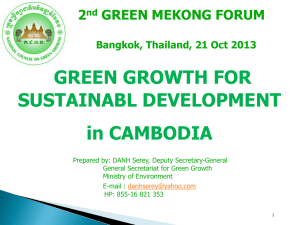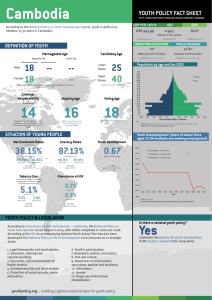File
advertisement
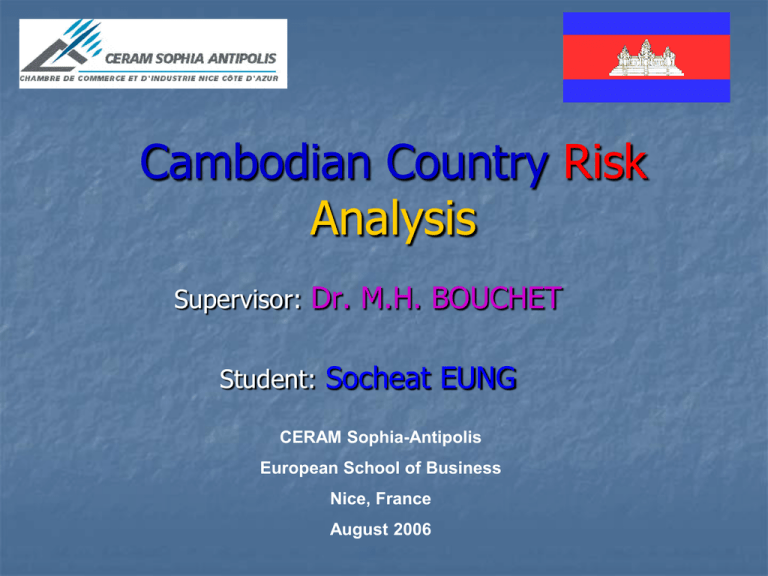
Cambodian Country Risk Analysis Supervisor: Dr. M.H. BOUCHET Student: Socheat EUNG CERAM Sophia-Antipolis European School of Business Nice, France August 2006 Content ►Cambodia’s History ► Country Overview ► Country Risk Analysis Economic Risk Analysis Financial Risk Analysis Polititcal Risk Analysis Legal & Judicial Risk Analysis External Related Risk Analysis ► Doing Business in Cambodia ► Conclusion & Recommendation Introduction Official name: Kingdom of Cambodia Form of State: Democratic with multi-parties Population: 13.9 million Land area: 181 035 sq km Climate: Tropical Location: Southeast Asia Currency: Khmer Riel (KHR) Capital: Phnom Penh Cambodia’s History During AD: Indianized states of Funan and Chenla 9th to 13th century: Khmer civilisation By 15th century: Cambodia was a center of the Khmer Empire, capital Angkor 1863-1953: Protectorate of France (Independence day on Nov. 9th) 1941-1945: Under Japanese occupation 1950s & 1960s: under the rule of King Norodom Sihanouk 1969-73: Bombing of US on Cambodia due to Vietnam 1970s: Civil wars, esp. Genocide regime(1975-79, >3million killed) 1980s: Vietnames evasion 1993: The first election under US’s administration 1998 & 2003: Hun Sen was elected as Prime Minister Cambodian Map Country Overview Power structure The king has no power Hun Sen is the most powerful Executive Power P.M. Hun Sen King Norodom Sihamoni Legislative Power Prince Norodom Ranaridh Judicial Power SupremeCouncil of Magistracy • King is the top of the country, but no power in politics • All decision in government made by Prime Minister Hun Sen • Legislative consists of National Assembly and Senate • Judicial power is namely independent institution, but in fact, it tends to be dependent on executive power People & Culture Age Structure Chinese Other Vietnamese 1% 4% 5% Betw een 15 and 64 years old 61% Less than 15 years old 36% More than 64 years old 3% Literacy Rate Ethnic Group Khmer 90% 100% 80% 60% 40% 20% 0% 74% Population literacy rate 85% 64% Male among total male Female among total female Country’s Resources Infrastructure: Two International airports(Phnom penh & Siem Reap) Roadway (12 323km) Railway (602km) not upgraded Waterway (2 400km) • Natural Resources: • Metals & mineral • Hydroelectric Power • Petroleum • Forestry • Timber and firewood Economic Outlook 2005 Expected growth: 7% Main drivers: textile, tourism, construction, & agriculture International trade expansion Stable fiscal and monetary performance Inflation: 6.7% GDP per capita: 441US$ Country Risk Analysis Econmic Risk Analysis Economic growth 9.00% 8.00% 7.00% 6.00% Cambodia 5.00% Laos PDR 4.00% Thailand 3.00% Vietnam 2.00% 1.00% 0.00% 2002 2003 2004 2005(pr) 2006(p) → Keep growing by 2004, at comparable rates to neighbors → Expected to lower due to oil price increase, low speed of critical reforms, external factor(VN membership into WTO, etc.) Economic Risk Analysis Inflation 8.00% 7.00% 5.60% 6.00% 6.70% 5.00% 4.00% 3.70% 3.50% 3.00% 2.00% 1.00% 0.50% 0.00% 2002 2003 2004 2005(pr) Low inflation rate though increase in oil price, Not problematic to the country 2006(p) Economic Risk Analysis Interest rates 25.00% 20.00% 15.00% 4.30% 4.20% 21.10% 21% 18.20% 18.70% 18.60% 17.30% 4.00% 16.70% 7.20% 7.00% 6.60% 3.90% 3.80% 3.70% 5.00% 4.10% 4.00% 16.70% 3.70% 10.00% 4.20% 6.60% 0.00% 3.70% 3.60% 3.50% 3.40% 2002 2003 2004 2005(June) Riel 12-months Deposits Rates Riel 12-months Lending Rates US$ 12-months Lending Rates US$ 12-months Deposit Rates ►Rates in Riel more than in US$ due to risk from Riel depreciation ►High interest rates discourage private sector Banking and Financial Sector National Bank of Cambodia (NBC) Central Bank Commercial Banks Specialized Banks Microfinance Institutions ▲NBC, established in 1980, is autonomous central bank. Its roles are: off-site inspection & on-site inspection of commercial banks Supervision and licensing of commercial banks, specialized banks and (MFIs). ►However, it is very difficult to access credits Government Budget Government Budget 20% 17% 16% 15% 15% • Large budget deficit still problematic even reaching target of revenue collection 15% 15% 11% 11% 10% 11% 11% 10% 5% • Poor public services deliveries 0% -5% -4% -6% -6% -4% -4% -10% 2002 2003 2004 2005€ 2006(p) Government Budget Financing Revenue/GDP Expenditure/GDP Deficit/GDP 100% 100% 89.30% 100% 100% 100% 80% 60% Strongly depending on foreign aids and loans to finance budget deficits 40% 20% 10.70% 0% 0% 0% 0% 0% 2002 2003 2004 2005(e) Foreign_Financing Domestic_Financing 2006(p) Financial Risk Analysis BOP Analysis • Increasing in export due to US & EU restrictions on China’s export Cambodia's International Trade (in US$ million) 3,822 4000 3500 3,166 3000 2,773 2,579 2500 2,454 2,275 1,970 2000 1,659 1500 • Increasing in import due to hug increase in oil price 1000 500 0 -500 -1000 -616 -609 -712 -1,049 -1500 2002 2003 Trade Deficit 2004 Exports 2005(p) Imports CAD generated by 0.0% • Inflation -1.0% • Strong economic performane • Government restrictions -2.0% Current Account Deficit to GDP ratio -2.4% -2.5% -3.0% -3.8% -4.0% -4.4% -4.1% -5.0% So, it will worsen foreign reserve 2002 2003 2004 2005(p) 2006(p) Debt Analysis Cambodia's Public external Debts (in million US$) 3,500 3,000 2,500 2,740 2,492 • Largly depending on foreign boorowing to reconstruct the country 3,180 2,976 2,000 1,500 1,000 21 500 28 26 29 0 2002 2003 Public External Debt 2004 2005(est.) Public Debt Service • Needing proper debt management to ensure viability of the country • Debt forgiveness and rescheduling (US & Russia) Cambodia starting to pay debt services on last decade loan More funds needed for debt services So, scarcity of funds for development unless domestic revenue is substantially strengthened Financial Ratio Analysis Solvency Ratios Debt to GDP Ratio 65% 60% • Debt/GDP ratio was relatively quite high 62% 60% 58% 55% • Estimated to go down in 2005 & 06 due to IMF’s debt relief 52% 50% 45% 2002 2003 2004 2005(est.) Official Reserve to Debt Ratio 29% 29% • OR/Debt used to ensure the country’s solvability toward creditors in the future 29% 28% 28% 27% 27% 27% 27% 27% • OR is in range of 26% & 29% 26% 26% 2002 2003 2004 2005(est.) Debt to Export Ratio • In overall, debt/export ratio >100% 200% 150% 150% 139% 121% 115% 100% 50% 0% 2002 2003 2004 2005(est.) • Decreasing gradually year after year • But large debt make Cambodia insolvent toward creditors Liquidity Ratios Official Reserves (in months of Imports) 3 2.9 2.8 2.6 2.5 2.4 2 1.5 1 0.5 0 2002 2003 2004 2005(est.) • Nagatively, the ratio decreasing slighly due to much increase in import • It’d not have enough reserves to compensate a large amount of imports in the future Debt service to Export Ratio 1.00% 1.00% 0.90% 0.80% 0.80% 0.70% 0.60% 0.40% 0.20% 0.00% 2002 2003 2004 2005(est.) • From 2003, debt service to export ratio decreasing slighly due to more increase in export than in debt service Monetary & Fiscal Policy Monetary policy • adoption of tight monetary policy and managed floating exchange rate • Economic growth lead expansion in money suppy & demand • Money suppy largely stems from foreign currency deposit • Largely, private sector need credit to finance business investment • Hovewer, difficult to acess credits Money Supply in Billion Riel 4,188 5000 3,643 4000 3,079 3000 2000 2,310 2,001 766 1000 122 1,349 1,205 1,115 908 111 192 162 135 0 2002 2003 2004 Local currency in circulation 2005(est.) Foreign currency deposit 2006(p) Other money supply Money Demand in Billion Riel 4,000 3,763 3,500 3,232 3,000 2,722 2,500 1,500 1,000 2,120 1,947 2,000 1,059 1,817 2,141 1,970 1,337 500 0 -500 -117 -128 2002 2003 Credit to private sector -209 2004 -192 2005(est.) Credit to public sector Other(*) -176 2006(p) Monetary & Fiscal Policy Fiscal policy Objective: to maintain a sustainable fiscal balance with gradual increases in budget allocation to maintain price stability in Cambodia's highly dollarized economy to ensure a level of spending that is consistent with macroeconomic stability Result in 2004 & 2005: slightly increased domestic revenue collection public expenditure restraint stability of low inflation rate However, there are distortion in domestic revenue collection and public expenditure due to inadequate operational funds and low salaries of public servants Foreign Exchange Risk Analysis Dollarization of econmy ►Official use of Dollar in economy Riel is less volatile against US$, comparing to Thai Bath and VN dong Depreciation in Riel against US$ due to economic slowdown in rural area where Riel is mostly used, versus in urban Even depreciation in Riel, current account deficit is wider and wider Foreign Exchange (Riel/US$) 4,116 4,150 4,100 4,031 4,050 3,980 4,000 3,950 3,935 3,900 3,850 3,800 2002 2003 2004 2005(est.) Political Risk Analysis Positive influence Prince Model (ADB/IMF/WB) King Norodom Sihanouk King Norodom Sihamoni Prime Minister Hun Sen Opposition leader Prince Norodom Ranaridh Negative Influence Political Situation Negative points Political conflicts: e.g. Government stripped opposition leader Sam Rainsy of his parliamentary immunity Sporadic civil unrest which can result in damage to business, e.g. Anti-Thai rioting in January 2003 Positive points Strong protection agiant expropriation In overall, political stability Open and liberal investment regime with national treatment of foreign investors Legal & Judicial Risk Analysis Based on civil law where the rule of law is set as the country’s basis Seperation of powers: Executive, Legislative, & Judicial Negative points: Judicial tend to be dependent on government Khmer civil system is ramnent of communist legal theory and under-resouced Opacity of regulatory system and incomplete legal framework for market economy Corruption is widespread in this sector Positive points: Significant reforms in the sector Laws is conformed to international standard due to TWO accession No pattern of discrimination against foreign investors Corruption Bribes Paid by Domestic Firms to Public Services 12% Domestic firms paid unofficially on business licensen authorities, followed by standard & safety inspection 4% 6% 39% 11% 13% 15% Business License Authorities Custom/Trade License Services Other Police Other Standard and safety Inspection Trade Agency/Inspectors Traffic Police Bribes Paid by Foreign Firms to Public Services 11% 3% Mostly, foreign firms paid unofficially on custom/trade license services 19% 67% Custom/Trade License Services Business License Authorities Other Police Other Cambodian Governance Indicators Aggregate Governance Indicators 27.1 Control of Corruption 6.9 49.3 13.3 35.7 Rule of Law 8.2 51.7 17.4 27.6 Regulatory Quality 51.2 9.9 44.3 44.2 65.4 Government Ef f ectiveness 14.4 18.8 51.9 Political Stability 41.7 24.8 30.6 7.3 Voice and Accountability 52.4 6.8 24.8 0 10 20 30 40 50 60 70 Percentile Rankings in 2004 Cam bodia Laos Thailand Vietnam Cambodia’s governance is relatively poor, comparing to Thailand, while Laos is the worst. Comparing with Vietnam, Cambodia is better in terms of regulatory quality and voice and accountability Corruption Perception Index (CPI) 8 7.9 7.6 7.5 7 6 5 4 3.8 3.3 3 2.6 2.3 2.2 2 1.7 1 0 Iceland USA France Thailand Laos Vietnam Cam bodia Indonesia Chad Source: International Transparency (IT) (CPI score: 10=highly clean, 0=highly corrupt) Cambodia is ranked at 130th out of 158 countries with the 2005 CPI score of 2.3 Cambodia is one of the worst countries in team of corruption External Related Risk Analysis Regional Intergration (ASEAN) Cambodia has become ASEAN member on April 30, 1999 with purposes: Political cooperation Economic & functional cooperation External relations However, Cambodia might face with the regional contamination risks, e.g. Asian crisis in 1997 In overall, the regional integration gives much more advantages and opportunities to develop country Cambodia’s WTO membership Cambodia has been a member of WTO since 13 October 2004 with: Advantages: Access to international markets Capacity building Good governance building Disadvantages: Difficilt to compete with competitors in local & international markets Doing business in Cambodia Country SWOT Analysis Strengths Inflation stability Low currency volatility Low labor cost Low tax payable Independent Central Bank Good recent macroeconomic performance High economic growth Dollarization of economy Macroeconomic stability Prosperous natural resources Hard work willingness of people Favorable culture for business management Liberalized economy and business Weaknesses Poor banking and financial system High corruption Inadequate government bureaucracy Low educated workforce Difficult to access credit Inadequate physical and financial infrastructure Weak legal and judicial institutions Country SWOT analysis Opportunities WTO membership Regional integration (ASEAN) Emerging market Democratic country Many reforms in many sectors Tourist destination (Angkor Wat...) Strong partnership with many international organizations Large proportion of active population (61%) Recent political stability Threats Political conflicts Hug external debts Crime and theft Large government budget deficit Border conflict with neighboring countries Growth Competitveness Index (GCI) 6 5.94 5.81 5 4.78 4.5 4.49 4 3.53 3.37 3 2.82 2.8 2.74 2.73 2.37 2 1 0 Iceland USA Malaysia France Thailand Indonesia Vietnam Cam bodia Paraguay Bernin Guyana Chad Source: World Economic Forum (score: 1 = the least competitive, 7 = the most competitive) Cambodia was ranked at 112th position among 117 countries with a relatively low score (2.82 out of 7), assessed in 2005 by World Economic Forum (WEF) Business Competitiveness Ranking Quality of the national business environment ranking Country BCI ranking Company operations and strategy ranking USA 1 1 2 Singapore 5 14 5 France 11 10 11 Malaysia 23 24 31 Thailand 37 30 37 Indonesia 59 50 59 Vietnam 80 81 77 Cambodia 109 103 108 Bolivia 113 115 112 Chad 116 116 116 Source: World Economic Forum 10 elements for doing Business Ranking by Each Element of Doing Business in Cambodia 144 Ease of closing business 127 Ease of enforcing contracts 117 Ease of trading across border 24 Ease of paying taxes 55 Ease of protecting investors 154 Ease of getting credit 84 79 Ease of registering properties Ease of employing and firing w orkers 140 137 Ease of dealing w ith licenses Ease of starting a business 133 Ease of doing business 0 20 40 60 80 100 120 140 Rank out of 154 Countries ►The most difficult: getting credits, closing business, dealing with licenses, starting business, enforcing contracts and trading across border. ►The easiest: paying taxes, protecting investors, employing & firing workers and registering properties In overall, ease of doing business in Cambodia is ranked at 133th out of 154 countries The Most Problematic Factors The Most Problematic Factors for Doing Business in Cambodia Corruption 80% •Corruption 55% Inefficient government bureaucracy Inadequately educated w orkforce 46% Inadequate supply of infrastructure 46% •Inefficient government bureaucracy 41% Access to financing Policy instability •Inadequate educated workfoces 34% 30% Government instability/coups 27% Poor w ork ethic in national labor •Inadequate supply of infrastructure 26% Tax regulations 18% Crime and theft Restrictive labor regulations •Access to credits 17% Tax rates The most problematic: 14% •Policy instability 11% Foreign currency regulation 10% Inflation 0% 10% 20% 30% 40% 50% Percentage of Respodents 60% 70% 80% Credit Rating COFACE gives credit rating « D » to Cambodia The high risk profile of a country’s economic and political environment with further worsen further a generally very bad payment record Conclusion & Recommendations Conclusion Good macro economic performance after peace establishment Good short-term performance, but not sure for long-run Some issues remaining: political conflicts, poor legal & judicial framework, corruption, poor infrastructures, poor financial & banking system, large debt etc. However, many strengths & opportunities to invest in Cambodia even poor international ranking Recommendations Cambodian government itself is the key to improve all sectors of the country with supports of strong willingness of Cambodian people, along with the great international aids & assistance Local & foreign investors should take a look on to invest in because Cambodia would be profitable business place References Books: Country Risk Assessment – A Guide to Global Investment Strategy – by M.H. Bouchet, B.Groslambert and E. Clark, published by Wiley Websides: 1. 2. 3. 4. 5. 6. 7. International Monetary Fund: www.imf.org World Bank: www.worldbank.org Global Finance: www.globalfinance.org Asian Development Bank: www.adb.org COFACE: www.coface.org World Economic Forum: www.weforum.org Transparency International: www.transparency.org Thanks for your attention

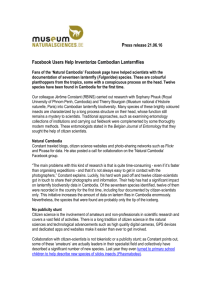

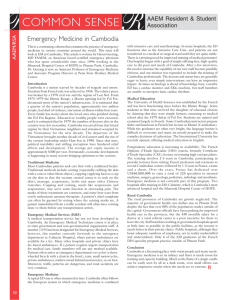
![Cambodian New Year - Rotha Chao [[.efolio.]]](http://s2.studylib.net/store/data/005298862_1-07ad9f61287c09b0b20401422ff2087a-300x300.png)
